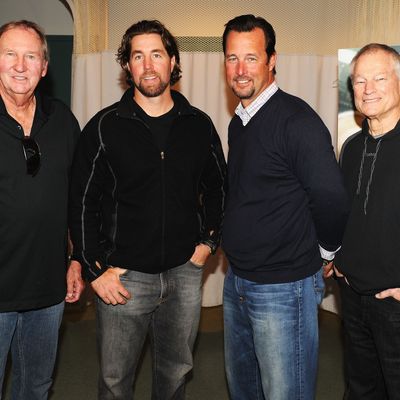
A current Met, a onetime Yankee, and a former member of the Red Sox united this weekend for a common cause: the endangered knuckleball. R.A. Dickey, Jim Bouton, and Tim Wakefield — all of whom are featured in the documentary film Knuckleball! — did their best to teach the unconventional pitch to the next generation of ballplayers during a clinic on Saturday night prior to the film’s premiere at the Tribeca/ESPN Sports Film Festival. The documentary, by award-winning filmmakers Ricki Stern and Annie Sundberg, combines game footage with dozens of interviews with sportswriters, players, and managers, and chronicles the 2011 season, in which Wakefield recorded his 200th (and final) major-league victory, before retiring and leaving Dickey as the sole big-league knuckleballer.
The knuckleball has always been something of an idiosyncratic pitch. With every other pitch in baseball, the pitcher tries to maximize the spin on the ball, increasing its torque. But when thrown correctly, the knuckleball has no spin whatsoever. Its late movement is achieved by gripping solely with the fingertips, and its velocity can dip below 60 miles per hour. There’s a montage in the film of great hitters like Derek Jeter and Ichiro Suzuki flailing away helplessly — but the knuckleball is only unhittable until it’s not. (Just ask Dickey, who gave up eight runs in four-and-a-third innings last Wednesday, after surrendering a combined three runs in his prior two starts.)
“I have about a 60 percent idea where it’s going to end up,” Dickey told us on Saturday. “If I start at the right height, I know eventually it’s going to be a strike. Where in the strike zone it’s going to be is up to the baseball gods.”
Former Yankee knuckleballer Jim Bouton — who wrote the classic Ball Four and says he’s working on a book about his childhood — is the poet laureate of knuckleballs. “You need the fingertips of a safecracker and the mind of a Zen Buddhist,” he says in the film. “It’s like trying to throw a butterfly into your neighbor’s mailbox.” The pitch can be frustrating to hit, you see, but it’s also difficult to throw effectively. Explained Bouton on Saturday night: “It’s almost impossible to throw a ball without spin.”
Knuckleballers don’t have to be strong or young, and because the pitch causes considerably less wear and tear on the shoulder than breaking balls or high hard ones, it can lengthen a pitcher’s career. As Wakefield says in the film, “It is a second chance type of pitch.” Indeed, when the Pirates told Wakefield in 1992 to convert from first baseman to pitcher or be released, he did whatever it took to stay in uniform, and that included being mentored by legendary knuckleballer Phil Niekro. “The decision wasn’t mine,” Wakefield told us. “The knuckleball was a pitch of desperation. I was drafted as a position player out of college and I couldn’t hit anymore. I just happened to have a pretty good knuckleball, just goofing around. It saved my career, just like it saved R.A.’s and Charlie Hough’s.”
In 2005, when Rangers pitching coach Orel Hershiser told Dickey — then a more conventional pitcher with Texas — to throw the knuckleball full-time, Hershiser arranged a meeting with Hough, who repositioned Dickey’s fingertips by 90 degrees from the ball’s runway to its horseshoe, just beneath the seam. But there’s more to throwing a knuckleball than learning proper finger placement. “We talked about different grips,” said Hough on Saturday, “but the biggest part was mental, the confidence. A bad day throwing a knuckleball is pretty bad and you have to put it behind you.”
Knuckleball! screens on April 27 and 28 at the Tribeca Film Festival. For details and clips, click here.